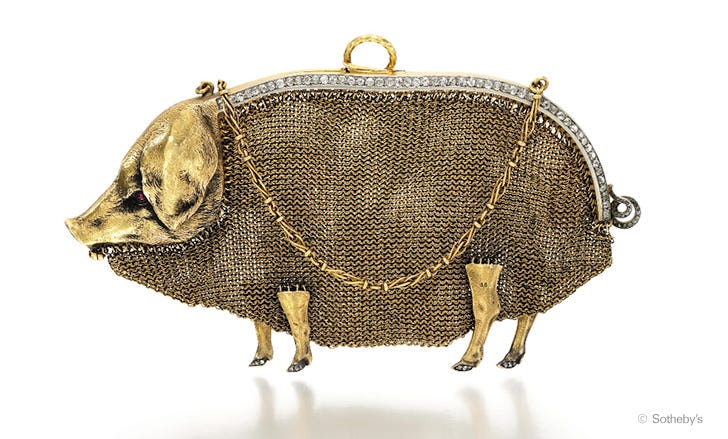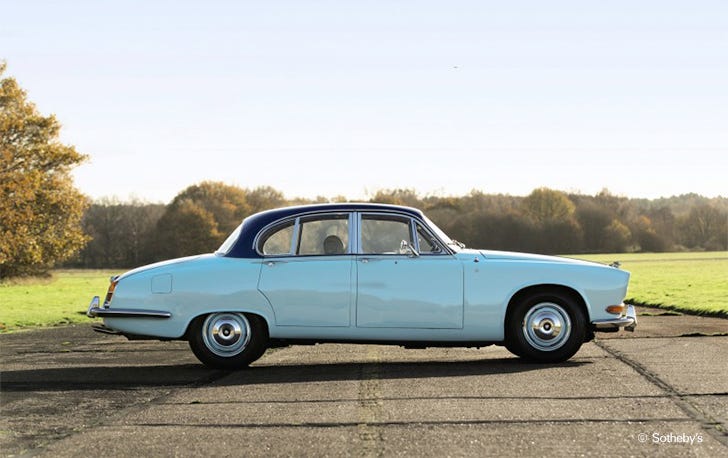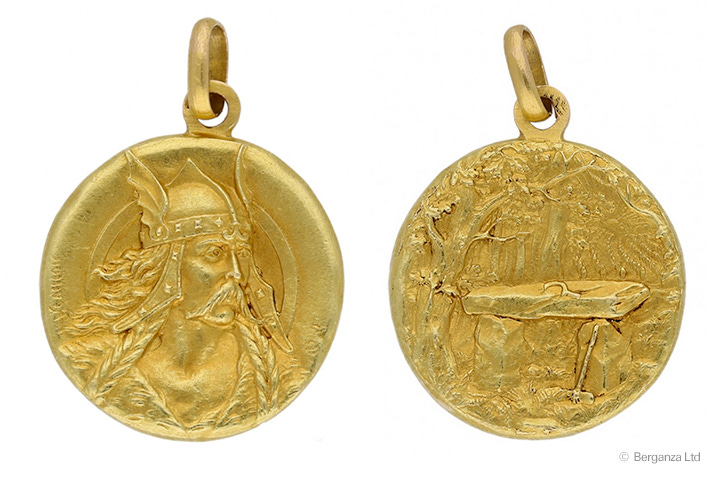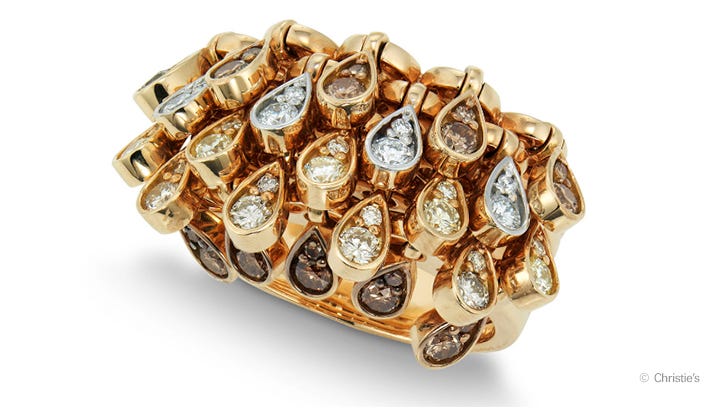Hi everybody! This Belle Époque ruby and diamond evening bag was created by Parisian jeweler Julien Duval and sold by the French firm Lacloche Frères. Circa 1905, it takes the form of an 18k gold pig, with a mesh body and cabochon ruby eyes. Rose-cut diamonds highlight the dainty little trotters and tail, and a line of cushion-shaped diamonds runs along the spine.
The bag is included in the “Family Collection of the late Countess Mountbatten of Burma,” live auction at Sotheby’s London on March 24. The sale includes a number of interesting items from the collection of Patricia, the second Countess Mountbatten of Burma, who died in 2017 at the age of 93. Patricia was the daughter of Louis, the First Earl Mountbatten of Burma and last Viceroy of India, and the great, great granddaughter of Queen Victoria. She was married to John Knatchbull, the seventh Lord Brabourne and a film producer who — under the professional name John Brabourne — was responsible for such brilliance as Murder on the Orient Express (1974) and Death on the Nile (1978). He also received Best Picture Oscar nominations as producer of Romeo and Juliet (1968) and 1984’s A Passage to India.
Patricia herself was one of those hands-on peers who threw herself into the war effort, entering the Women’s Royal Navy Service in 1943 at the age of 19 and later becoming Colonel-in-Chief of the “Patricia’s” (a.k.a. Princess Patricia's Canadian Light Infantry, an infantry regiment of the Canadian Army originally named for a granddaughter of Queen Victoria).
Patricia was also on board during the IRA bombing of her family’s fishing boat off the coast of County Sligo, Ireland in August 1979 — an attack that killed her father, mother-in-law and 14-year-old son Nicholas, as well as a young deckhand from County Fermanagh. Patricia, her husband and their son Timothy all were injured but survived. Despite her loss, she later applauded Queen Elizabeth’s historic 2012 meeting with former IRA commander-turned-politician Martin McGuinness, stating “I think it's wonderful. I'm hugely grateful that we have come to a point where we can behave responsibly and positively.”
The Spectator notes that the Kent estate owned by Knatchbull’s family goes back to 1485, and Patricia and John “were among few married couples in England to each hold peerages and to have each landed great inheritances,” so this sale was guaranteed to be interesting and eclectic.
In addition to the piggy, some other items of interest include this diamond bracelet commissioned by Queen Victoria, complete with a miniature of her husband Prince Albert as he would have looked at the age of six. I also like this circa 1945 gold and enamel Girl Guides bracelet, a gift from Patricia’s father that referenced the 20-member Buckingham Palace Company, which was created in 1937 so Princess Elizabeth could become a Girl Guide. Elizabeth was elected second of the Kingfisher Patrol, and Patricia was Patrol Leader.
Don’t miss Earl Mountbatten’s 1967 Jaguar 420, painted the ‘Special Mountbatten Blue’ exterior color that was used on most of his personal automobiles, with his crest still intact on the doors.
The sale also features a collection of Fabergé items, including this circa 1899-1903 Imperial gold-mounted guilloché enamel cigarette case by workmaster Michael Perchin.
According to the lot notes, the case is recorded in the Fabergé ledgers and was “jointly purchased by Emperor Nicholas II (1868–1918) and Empress Alexandra Feodorovna (1872-1918) from the St Petersburg branch of Fabergé on 12 February 1901 for 200 roubles, each paying half.” It then descended to Empress Alexandra's sister and on to her son, the First Earl Mountbatten.
Speaking of which, there’s recently been quite a kerfuffle in Fabergé-land, and it all has to do with an exhibit that just closed at the Hermitage Museum in St. Petersburg, Russia. Entitled “Fabergé, Jeweller to the Imperial Court,” the exhibit featured items from the Hermitage and a handful of small private museums. Many of the pieces came from the collection of Alexander Ivanov, a Russian oligarch and collector who first made news in the Fabergé world in 2007, when he dropped $18.5m for the Rothschild clock egg (which he later gave to Putin, who donated it to the Hermitage).
Many of Ivanov’s pieces in the Hermitage exhibit were touted as “new discoveries” of Fabergé-commissioned Imperial Easter eggs and tiaras. That “Fabergé” designation was swiftly questioned by many in the research world, and most vociferously by one dealer and expert in particular: Andre Ruzhnikov.
Rumblings about the questionable items started coming out last spring, first with an article by American researcher DeeAnn Hoff in the Fabergé Research Newsletter, which is ground zero for new Fabergé scholarship. (The newsletter and Fabergé Research Site are run by Christel Ludewig McCanless, who knows so much about Fabergé she literally wrote an encyclopedia about the eggs; I spoke with her and her co-author Will Lowes about it back in 2003.)
Hoff’s article took a magnifying glass to one of the prizes of the Hermitage exhibit — the supposed 1904 “Wedding Anniversary Egg” (pictured above in the Hermitage catalog) — and presented a compelling and well-illustrated argument that the portraits of the Imperial family seen on the egg were based on historical photographs taken years AFTER Czar Nicholas II supposedly presented it to the Empress Alexandra in honor of their 10th anniversary. Whoopsie!
Despite that research, the Hermitage exhibit opened in late November with the Wedding Anniversary Egg’s spurious Fabergé label still intact. There’s no question that any “new discovery” of a Fabergé Imperial egg — much less MULTIPLE ones, with some tiaras thrown in to boot — should have been a world-class event “comparable to the discovery of, say, a new Leonardo,” in Ruzhnikov’s words, but the exhibit opened to…..silence, basically. “Fauxbergé,” a term coined by renowned Fabergé scholar Dr. Géza von Habsburg1, is the scourge of the Fabergé world and experts are on a constant patrol for fakes, so the collective stink eye cast upon this exhibition by the Fabergé community at large (which is a VERY AVID community) spoke volumes. Habsburg himself told the BBC (article’s in Russian, sorry): “Judging by the photographs and descriptions published on the Internet, all the so-called ‘newly found Imperial Fabergé Easter eggs’ from the museum in Baden-Baden presented in this exhibition are fakes, in my opinion.”
Meanwhile, back in London, Andre Ruzhnikov was stewing. Never one to mince words (he regularly publishes snarky auction reviews on his website), he finally let loose on January 13 and published “Forgeries In The Hermitage. An Open Letter to Mikhail Piotrovsky” on his website. Piotrovsky is the director of the Hermitage, and in the letter, Ruzhnikov excoriates him for allowing a number of “tawdry fakes” — including the Wedding Anniversary Egg — from small, questionable museums into the great and glorious Hermitage:
I struggle to understand why the Hermitage should co-operate with small private museums, and their doubtful collections, rather than with museums of global repute. I trust the Museum’s curators can sleep easy with their choice. The goal of your ‘partners’ is clear: to legitimize counterfeits and enhance their market-value by exhibiting them in the Hermitage. Perhaps the owners of these ‘chefs d’œuvre’ view the Hermitage itself as a prospective buyer. What on earth are the benefits of such collaboration for your Museum?
Shots fired! Ruzhnikov received no reply from Piotrovsky other than “an obscure quote from [your] catalogue preface, and accusations along the lines of ‘what nonsense,’” so on January 20th (an English translation was released on January 22) he posted a new open letter that proceeded to dismantle the provenance documentation Ivanov had furnished for the Wedding Anniversary Egg. The next day a conference was held at the Hermitage, which Ruzhnikov states:
yielded nothing more than 90 minutes of drivel from Alexander Ivanov: a never-ending diatribe consisting of foul language, threats, fake quotes and confused argumentation bereft of logic. Along the way Mr Ivanov revealed that I was a ‘scumbag,’ a swindler and a thief. Nothing he said affects my judgment about his objects’ (lack of) authenticity in any way.
Ruzhnikov continued doggedly on with another letter, “Hermitage: Ivanov’s Tearful Tiaras,” in which he systematically took down the tiaras. (The accompanying Photoshop of Ivanov wearing one of the tiaras was maaaaybe a bit too much, but, as my mother always says, “you have to make your own fun.”) He later followed up with an additional post exposing a questionable hardstone soldier figure also included in the exhibit.
Piotrovsky never responded directly to any of this, although the museum did post an article claiming that Ruzhnikov was biased because he had previously acted as a buyer for Viktor Vekselberg, another Fabergé collector and oligarch (he’s the one who, with Ruzhnikov’s help, purchased the blockbuster Forbes collection of Imperial Easter eggs in 2004). The Hermitage article basically says that Ivanov once managed to yoink a Fabergé snuffbox Ruzhnikov had wanted to purchase for Vekselberg at a previous Christie’s auction, and that’s why he’s pissy.
Piotrovsky also refused to speak with the BBC, and instead made some noncommittal statements to the effect that Fabergé always arouses emotion and he welcomes all debate. But that Russian BBC article brought up a valid point:
Experts who discussed this topic in personal conversations with Piotrovsky said that they had the impression that perhaps the decision about the controversial Fabergé eggs lies outside the authority of the director of the Hermitage, and the museum is more of a victim in this story.
I mean, he may be trying to get sympathy or play both sides, but Russia IS the land of defenestration and poisoned underwear; would you want to say no to a Friend of Putin?
Anyway, the exhibit closed on March 14, and the next day the Spring/Summer issue of the Faberge Research Newsletter arrived in my inbox, chock full of further research debunking the Hermitage attributions. And, finally, Mikhail Piotrovsky broke his silence on March 17 and told the Art Newspaper Russia that:
“Any exhibition at the Hermitage Museum is a research project. Technical analysis of the objects on display is part of the Hermitage’s Fabergé research programme. It is being carried out with the owners’ consent. The results of these studies and of panel discussions are to be published later.”
So there you have it. There’s far more detail to all of this, but I’ve already gone on WAY too long. The debate will no doubt continue until the imminent heat death of the universe, so get used to it!
Circa 1900, this French Art Nouveau 18k gold pendant depicts Vercingetorix (82-46 BCE), the king of the Arverni tribe who united the Gauls in a revolt against the Romans during Julius Caesar’s Gallic Wars. Although they put up a good fight, the Gauls ultimately couldn’t withstand the might of the Roman forces, and, in an effort to save the lives of his men, Vercingetorix surrendered himself to Caesar at the Battle of Alesia in 52 BCE. He was imprisoned in Rome for almost six years before being trotted out for public display in the first of Caesar's four triumphs in 46 BCE, after which he was executed. He later became celebrated as a French nationalist hero during a 19th century bout of Celtomania led by Napoleon III, and was the subject of numerous public statues and works of art — including this pendant.
I particularly like the reverse, which features a romanticized druidic scene including an oak tree, axe, sickle, and megalithic structures including a trilithon (two large vertical stones supporting a third stone set horizontally across the top) and multiple rows of menhirs, or standing stones.
After padparadscha, spinel is my favorite gemstone. Referred to by the GIA as “the great imposter,” spinel has been fooling people into believing it’s a ruby for literally centuries: Some of the most famous “rubies” of history are actually spinel, including the “Black Prince’s ruby,” which somehow manages to draw the eye away from the massive Cullinan II diamond in England’s Imperial State Crown, and the “Timur Ruby,” which belonged to several Mughal emperors and was later set into a necklace for Queen Victoria.
Although it’s best known for an intense red or pink color (due to the presence of chromium), spinel appears in a range of shades from red and orange to purple, blue, violet and bluish-green. You can see that range in the bracelet above, which features cushion-shaped spinels of various red, grayish-purple and blue hues interspersed with red spinels that are bordered by brilliant-cut diamonds. The bracelet is included in the “Fine Jewels” sale at Sotheby’s London on March 31.
During the late 18th century, a trend developed for incredibly fine, delicate pastoral scenes that were carved out of ivory in almost microscopic detail. Called “micro-carving,” the scenes were usually incorporated into jewelry or snuff boxes, and a pair of German carvers called G. Stephany and J. Dresch were the best known practitioners of the art. They worked in Bath, England in the 1790s, and Rowan & Rowan identifies the ca. 1790 carving above as their handiwork. Depicting a shepherd tending his flock alongside an ivy-wrapped tree, the carving is set as a gold brooch and protected under a crystal. It measures just 1.25” x .75”.
Ok, I’ve already talked your ear off (uh, written your eyes out?), so I’ll close with this ring. No big story or anything. The ring is by Florence, Italy-based jewelers FerrariFirenze, and features 46 round brown, yellow and colorless diamonds set in 18k rose gold frames that flip back and forth, making for a very high-end fidget toy that I desperately want to play with. It’s currently on offer in the Jewels Online auction closing Thursday at Christie’s Hong Kong.
That’s it for today. Have a good week, everyone! Be kind to yourselves and try to get some sunshine. xxx
I am compelled to mention that the good doctor’s name is actually Géza Ladislaus Euseb Gerhard Rafael Albert Maria von Habsburg, Archduke of Austria, Prince of Hungary and Bohemia. I have met him twice and he is thoroughly charming and does not exhibit a Habsburg jaw. Despite the clamoring of my treacherous brain, I refrained from asking him if he planned to have his heart buried in a separate location from his body, and I can only offer you my apologies for letting down the side.
Thanks for reading, and if you haven’t already subscribed, sign up here:












I would D I E for that little pig evening bag! What could you even carry in it? Who cares.
I can't believe the low estimate on it- it gave me a moment of utter joy. That always happens though - I remember, way back in the Toast days, you featured a gorgeous pair of aquarium earrings and the auction estimate was shockingly low, maybe even under $1,000. It lulled me into bidding and then I was crushed when they ultimately sold for $15,000. I still think longingly about them. They would have gone so nicely with my piggy evening bag!
Oh Monica! Your submissions on The Hairpin were some of my favorites. I would always save them for my lunch break so I could really hunker down and enjoy them. I love your combination of passion for interesting pieces and your ability to tell the history of them in such an engrossing way. I only just found you here and I am so grateful to see that your style is a lovely as it ever was. Please, please, feel free to ramble on. Just know we are gobbling up every bit.